Syrian Ba’athism – Allies with Imperialism When Possible – Never a Radical Regime
There are those who, with civil insurrection in Syria, are lamenting the ‘radical’ credentials of the Syrian regime and the Ba’athists. Such people confuse a desire to retain an element of independence from the USA (the main crime of Saddam Hussein) with radicalism. In fact the Assad regime came to power when Israel threatened to attack Syria if it intervened in Black September, the attack in Jordan by King Hussein’s forces against the Palestinians. The Assad family has always been a conservative ruling clique.
 |
| [Hafez al-Assad. Image from Wikipedia.] |

|
| Arafat at a rally in West Beirut |
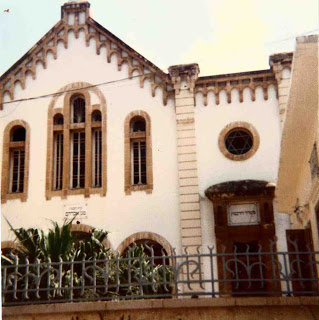 |
| Lebanese Synagogue at Wadi Abu Jamil – attacked by the Phalangist forces and defended by the PFLP |
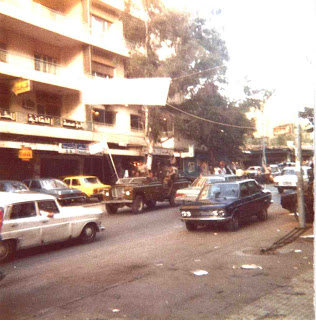 |
| typical Beirut street |
 |
| Another example of Israel’s contribution civilisation – near Sidon |
 |
| Falls Road Belfast where there were many murals to the Palestinians |
 |
| George Habbash of the PFLP |
 |
| Our group with PLO guide |
 |
| Palestinian Photo Exhibition |
 |
| Republican mural in West Belfast |
 |
| Sitting among the ruins – Roman I think! |
 |
| Ruins of Tel al Zatar |
 |
| Ruins of Tel al Zatar |
 |
| Ruins of Tel al Zatar |
 |
| Devastatuib of Tel al Zatar |
 |
| Devastatuib of Tel al Zatar |
 |
| Devastatuib of Tel al Zatar |
 |
| Devastatuib of Tel al Zatar |
 |
| Devastatuib of Tel al Zatar |
 |
| Devastatuib of Tel al Zatar |
 |
| Devastatuib of Tel al Zatar |
 |
| Walid Jumblatt of the Druze |
 |
| Hospital after Israeli air raid |
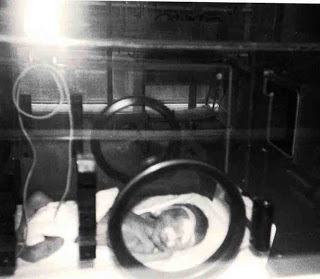 |
| Baby unit and Israeli terrorist target |
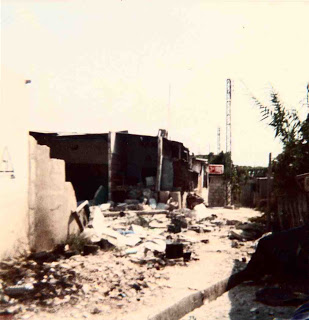 |
| More Israeli devastation |
People forget, as the Angry Arab Blogger reminds us, of the time when the Left was winning the Lebanese Civil War against the Phalangists and other fascists and sectarians. On this occasion both Israel and the USA gave Syria the green light to enter Lebanon with the express purpose of attacking the leftist forces of the Kurds, Murabitoun and PLO among others and shoring up Israel’s friends, the Christian Phalange, named after the Spanish Falange of General Franco.
 |
| Another terrorist target
|
In the course of the attack the Palestinian refugee camp of Tel al-Zatar was attacked by the Phalangists and some 2,000 people massacred. Yassir Arafat, who was reluctant to join the Left in the first place, played a particularly heinous role. Later, after Israel attacked Lebanon in 1982, there was a similar massacre in the Sabra & Chatilla camps. Israeli soldiers provided protection and flares for the butchers of the Gemayel camp, seeking revenge after the assassination (by the Syrians) of Bashir Gemayel. The author of that massacre was the living dead (they haven’t yet put him to sleep) – Israel’s butcher General Ariel Sharon.
 |
| Sitting in the orchard of a refugee camp
|
I visited Lebanon in 1979 along with others and the overwhelming feeling I got then was that an Israeli attack of the kind in 1982 was but a matter of time. West Beirut was run by a conglomeration of groups – the Kurds under the Jumblatt clan, the PLO’s different groups, the Nasserite Murabitoun and Lebanese Communist Party and others. We saw and visited a number of camps including Sabra & Chatilla and one of the group and myself made a journey across the divide between West and East Beirut, manned by the small Lebanese army into East Beirut. The taxi drivers would not take you across and you had to get another taxi the other side.
 |
| rally in West Beirut
|
What was saw, as the pictures demonstrate, was the remnant of the utter savagery that befell Tel al Zatar. Buildings with gaping holes in them and not a soul living there. On our way back we were arrested by the Lebanese Army and held for a few hours but we eventually convinced them that as guests of the PLO it would not make sense for them to detain us any longer.
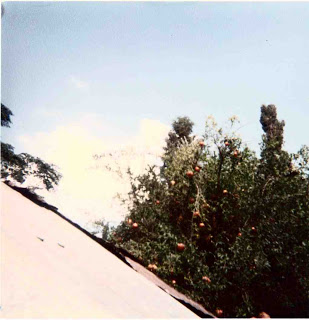 |
| Orange grove amidst Israeli devastation |
We didn’t have visas for Lebanon. The Lebanese Embassy in London refused us visas because they were run by the Phalange so we flew to Damascus, stayed with the PLO there and were taken one night in a jeep across the border. I can remember getting out and seeing the beautiful vista of Damascus in the night from the mountains. At dawn we arrived in Lebanon and stayed in the Hotel Triomphe in West Beirut, which the Israeli bombers destroyed in 1982.
 |
| Unknown Palestinian teenager
|
We visited Sidon and Tyre, the ancient Phoenician city named in the Bible, as well as Nabatiyeh, a crossroads, market town and refugee camp which the Israelis regularly bombed. Israel continuously bombed Lebanon and those who are fooled into believing Israel is laying siege to Gaza because of the pea shooters they occasionally aim, should bear in mind that Israel constantly and without let up bombed Lebanon during the 1970’s.
 |
| Backstreet of Palestinian refugee camp – notice open sewers
|
In the very south there was a fiefdom that Israel had carved out under a renegade Lebanese Army Major Haddad. He was based in Castle Beaufort, an old Roman castle, which Israel turned into a centre for torture (never say the Zionists don’t have their own cultural practices). I’ve dug out these photos from an old album that had lain forgotten for 30 years.
 |
| Medical staff at Palestinian hospital |
But the moral is that we can only rely on ourselves, not ‘leaders’ who make radical noises to cover their own corruption like the Assads.
Tony Greenstein
Hafez Al-Assad in 1976
Jun 22 2012 by As’ad Abukhalil
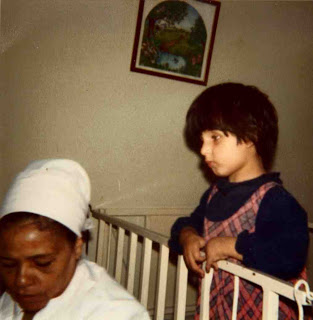
People of my generation cannot (and should not) forgive and forget. What happened in 1976 changed the course of contemporary Lebanese history and prolonged the agonizing years of the civil war. In 1976, the PLO-Lebanese National Movement (LNM) coalition was on its way to defeat the pro-Israeli Phalanges militias in Lebanon, after they were the ones who started the civil war on behalf of Israel and the US.
 |
| Camp near Nabatiyeh in south |
According to Newsweek magazine at the time, the PLO-LNM joint forces controlled more than 80 percent of Lebanese territory. They reached all the way to Oyoun el-Siman in Mount Sannine and Kamal Jumblatt famously told Abdul-Halim Khaddam that the next meeting would be held in Bikfaya (the stronghold of the Phalanges and the birth place of the Gemayyels).
 |
| Lebanese Synagogue at Wadi Abu Jamil |
Arafat was forced to join the offensive after his senior lieutenants made it clear that they would not go along with his policy of neutrality in a war that aimed at defeating the PLO in Lebanon. Some senior Fatah leaders, like Abu Salih, would take advantage of Arafat’s absences from Lebanon to provide weapons to the Lebanese factions. Arafat was very restrained in his policies and Jumblatt often complained about the quality of weapons that Arafat provided.
 |
| Girls outside a workshop in a refugee camp |
In 1976, the Syrian regime intervened militarily in Lebanon on the side of the Phalanges and Israel. The record is available (from Henry Kissinger’s memoirs to the memoirs of Israel leaders): Syria and Israel reached an understanding in Lebanon.
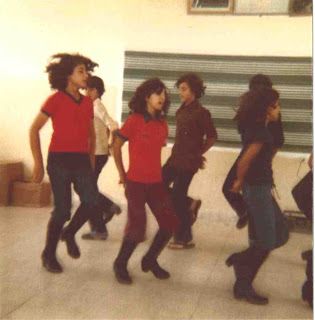 |
| Palestinian youth |
The understanding was that Syrian troops would enter Lebanon to defeat Israel’s enemies provided that the Syrian troops stay north of the Litani river.
 |
| Author with Palestinian child |
The Syrian troops strictly adhered to the agreement all the way until their humiliating withdrawal from Lebanon in 2005. Never once did Syrian troops dare cross south of the Litani river no matter how brutal and savage Israeli attacks on South Lebanon were. The Syrian regime intervened to smash a promising revolutionary movement that would have changed the map of the Arab East.
 |
| Arafat taking the salute |
To be sure, there were problems in the PLO-LNM that would force one to tame his/her enthusiasm and revolutionary fantasies. Arafat would not have permitted a revolutionary base in Lebanon (as George Habash worked to establish an Arab Hanoi north of Palestine) and Kamal Jumblatt was a sectarian feudal leader who had non-revolutionary credentials and calculations. But the masses of the LNM were ready for a revolutionary fight and for the only time in the 20th century, the mass audience of the LNM was non-sectarian and had presence in every corner of Lebanon.
 |
| Art Exhibition |
There was an opportunity to defeat once and for all the pro-Israeli militias of the Phalanges and punish them for starting the civil war. More importantly, there was an opportunity to end the civil war in 1976, one year after it had started. So many tens of thousands of dead and injured would have been spared.
 |
| workshop in a refugee camp |
The Syrian regime would have none of it. It did not want Lebanon to slip out of its grip and it also did not want the armed Palestinian and Lebanese revolutionary movements to drag the Syrian regime into an unwanted confrontation with Israel.
 |
| Palestinian Photo Exhibition |
People of my generation still remember that famous speech by Hafez al-Assad at Damascus University. All Phalanges and later Lebanese Forces leaders would quote from it by heart. It was a wholesale attack on the Palestinian and Lebanese resistance movement and it claimed that the objective of the movement was an extermination of the Christians.
 |
| A dancing group with a difference |
Assad was a hated man at that time. Every few days we would hear gunfire in the air and hope that it was a celebration of Hafez’s assassination.
 |
| What was left of a classroom after Israeli attack against ‘terrorists’ |
Syrian troops entered Lebanon with Western blessings. Abu Jihad and Arafat did not want a real fight and only provided symbolic resistance. Only radical Lebanese and Palestinian organizations put up a good fight. The Nasserist troops in Sidon famously attacked Syrian tanks. Even Ahmad Jibril’s PFLP-GC and the Syrian Social National Party (two tools of the Syrian regime nowadays) stood against the Syrian regime.
 |
| Our group |
 |
| Child standing in the rubble of Israeli attack |
The Amal movement was one of the few exceptions and stood by the Syrian regime, but its offices all over Lebanon were taken over in two days. It was that weak at the time when the Left prevailed in Lebanon in Shia areas of the country.
 |
| Israel’s handiwork |
The regime did not only take over Lebanon north of the Litani, it also entered into a Faustian alliance with the Phalanges and facilitated the fall of the Tal Az-Zatar camp – the Syrian regime and Israel were on the same side. A small leftist faction, the Socialist Arab Action Party-Lebanon took the initiative and declared guerrilla warfare on Syrian troops.
 |
| Mediterranean from the American University of Beirut |
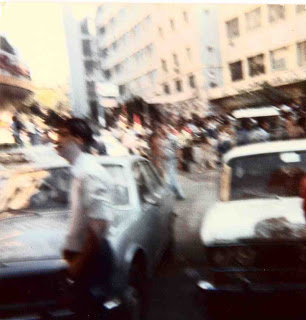 |
| bustling Beirut Street |
The Syrian regime was savage. Those who were suspected of aiding the resistance movement were tortured and shot – the lucky ones were put in al-Mazzeh jail to languish for years.
 |
| School building destroyed by Israeli bombers |
 |
| Beirut from the mountains |
We don’t have fond memories of the Syrian regime in Lebanon, no matter what side one is on. The Amal movement may be the only consistently pro-Syrian regime party and its media are more crude in supporting the regime than Syrian regime media itself. But what happened in 1976 should serve as a lesson to those who still harbor illusions about the intentions and aims of the Syrian regime.
 |
| Hospital attacked by Israeli bombers |



















































